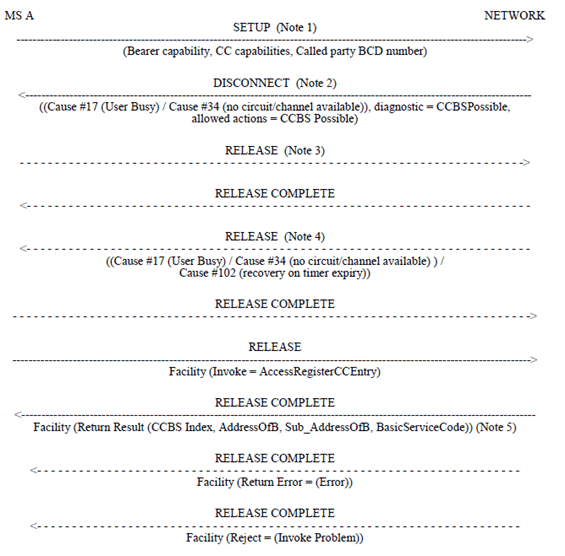Content for TS 24.093 Word version: 18.0.0
...
1 Scope p. 5
The present dcoument gives the stage 3 description of the Completion of Calls to Busy Subscriber (CCBS) supplementary service. The present document specifies the procedures used at the radio interface (Reference point Um as defined in TS 24.002) for normal operation, activation, deactivation, invocation and interrogation of the completion of calls to busy subscriber supplementary services. Provision and withdrawal of supplementary services is an administrative matter between the mobile subscriber and the service provider and cause no signalling on the radio interface.
In TS 24.010 the general aspects of the specification of supplementary services at the layer 3 radio interface are given.
3GPP TS 24.080 specifies the formats and coding for the supplementary services.
Definitions and descriptions of supplementary services are given in TS 22.004, 3GPP TS 22.08x and 3GPP TS 22.09x-series. Technical specification TS 22.093 is related specifically to the Completion of Calls to Busy Subscriber supplementary service.
The technical realization of supplementary services is described in technical specifications TS 23.011, 3GPP TS 23.08x and 3GPP TS 23.09x-series. 3GPP TS 23.093 is related specifically to Completion of Calls to Busy Subscriber supplementary service.
The procedures for Call Control, Mobility Management and Radio Resource management at the layer 3 radio interface are defined in TS 24.007 and TS 24.008.
The following supplementary services belong to the call completion supplementary services and are described in the present document:
- Completion of Calls to Busy Subscriber (CCBS) (see clause 4).
2 References p. 5
The following documents contain provisions which, through reference in this text, constitute provisions of the present document.
- References are either specific (identified by date of publication, edition number, version number, etc.) or non-specific.
- For a specific reference, subsequent revisions do not apply.
- For a non-specific reference, the latest version applies. In the case of a reference to a 3GPP document (including a GSM document), a non-specific reference implicitly refers to the latest version of that document in the same Release as the present document.
[1]
TR 21.905: "Vocabulary for 3GPP Specifications".
[2]
TS 22.004: "General on supplementary services".
[3]
[4]
TS 22.030: "Man-Machine Interface (MMI) of the Mobile Station (MS)".
[5]
TS 22.093: "Completion of Calls to Busy Subscriber (CCBS) Service description, Stage 1".
[6]
TS 23.011: "Technical realization of supplementary services".
[7]
TS 23.093: "Technical realization of Completion of Calls to Busy Subscriber (CCBS)".
[8]
TS 24.002: "GSM-UMTS Public Land Mobile Network (PLMN) access reference configuration".
[9]
TS 24.007: "Mobile radio interface signalling layer 3 General aspects".
[10]
TS 24.008: "Mobile radio interface layer 3 specification".
[11]
TS 24.010: "Mobile radio interface layer 3 Supplementary services specification General aspects".
[12]
TS 24.080: "Mobile radio interface layer 3 supplementary services specification Formats and coding".
[13]
TS 24.083: "Call Waiting (CW) and Call Hold (HOLD) supplementary services - Stage 3".
3 Definitions and abbreviations p. 6
3.1 Definitions p. 6
For the purposes of the present document the following definitions apply.
Subscriber A:
The user of MS A, requesting CCBS.
Destination B:
The entity addressed in the original call set up, which is busy when first called by subscriber A.
3.2 Abbreviations p. 6
For the purposes of the present document the following abbreviations apply:
CCBS
Completion of Calls to Busy Subscriber
MS A
Mobile Station of subscriber A
NDUB
Network Determined User Busy
Further related abbreviations are given in TR 21.905.
4 General p. 7
4.1 Overview p. 7
CCBS allows a calling subscriber A, encountering a Network Determined User Busy (NDUB) called destination B, to be notified when destination B is idle and to have the network reinitiate the call to destination B, if subscriber A desires.
All of the radio signalling specific to CCBS is at the subscriber A-side. Each procedure is described in turn. There is no radio signalling specific to CCBS at destination B-side. The radio signalling on the destination B-side uses basic call signalling procedures only.
A mobile station that supports CCBS shall support the requirements of the following options used in TS 24.008:
- Prolonged Clearing Procedure;
- Network Initiated Mobile Originated Connection Management (MO CM) Connection Request;
- Network initiated MO call.
- CCBS Request activation; and
- Network initiated MO call.
4.2 Activation p. 7
When CCBS is allowed the network shall give subscriber A the option of activating a CCBS Request.
The network shall send a DISCONNECT message to MS A (cause #17 (User Busy) or cause #34 (no circuit / channel available)) with diagnostic field indicating CCBS is Possible and allowed actions indicating CCBS is Possible. The network starts the retention timer T1 when it sends the DISCONNECT message. The MS shall not release the connection with the network if allowed actions is present.
If subscriber A attempts to activate a CCBS Request, MS A shall send a RELEASE message, with the Facility information element indicating CCBSRequest and the network shall stop T1. If the subscriber A does not accept CCBS activation, the MS shall send normal RELEASE message and the network shall stop T1 and continue normal call clearing. If the timer T1 expires before the RELEASE message is received from the MS, the network shall continue normal call clearing.
If the network accepts the activation attempt, it shall acknowledge it by sending a RELEASE COMPLETE message containing the Facility information element with the CCBS index and optionally the AddressOfB, SubAddressOfB and the BasicServiceCode. If the network rejects the activation attempt, it shall send a RELEASE COMPLETE message containing the Facility information element with a return error indication.
If a TCH has been allocated for the initial call and there are no further need for this channel configuration, the network may reconfigure the ongoing connection from TCH(s) mode to SDCCH only mode while waiting for further user input activity.
It is a network option to maintain the ongoing connection in TCH mode while waiting for further user input activity.
SS Version Indicator value 3 or above has to be used.
